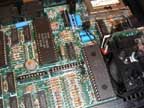
Initially coded the ZX83 (The Spectrum was supposed to be the ZX82)
this was supposed to be Sinclair's Quantum Leap from 8-bit games
machines (even though he hated the fact that people did nowt but play games
on 'em) to 32 bit (ish) supremacy - 128K memory, full multitasking, 'proper'
apps from Psion, SuperBASIC, and you really needed to have a monitor for proper
use since the 40 column 4-colour display on a TV was poor to say the least.
Oh, and it had non-standard serial ports (the 'phone' style from the Speccy+
128), those bloody microdrives, and if you put enough options on the sideways-facing
option slot you could end up with a machine that was 4 feet long....yep, that's
right, over 1 metre. Cost savings were made by Uncle Clive using the cheaper Motorola 68008 instead of the full-blown 68000 that would've increased the size of the motherboard considerably.
In true Sinclair style it was marketed long before it was ready, resulting
in initial shipments needing an extra ROM 'dongle' out the back because they
couldn't fit SuperBASIC into 32K. Now if only I had one of those *now*
:) The Microdrives, while still pretty revolutionary, were still pretty crap
really, and most of the reviewers bemoaned the lack of a 3.5" floppy drive
or even the interface for one. That was left up to the likes of Cumana and
Medic Data systems.
Software was done by Psion - now widely recognised as the purveyors of damn
fine personal organisers. They produced 4 apps for the QL - Easel (art), Quill
(word processing), Abacus (spreadsheet) and Archive (database). They were bundled with the machine, hence the 2 little microdrive
folders visible in the first pic below - the other folder contained 4 blank
carts. The 4 software packages were later merged into a bigger one called XCHANGE that ran from ROM on the ICL One-Per-Desk/Merlin Tonto and from disk on the CST Thor - a machine that used the QL motherboard as its base.
All in all, the machine WAS received well, despite the complaints. Even to
this day there are fans of the QL producing extra software for it, there's an
enhanced OS called Minerva, an enhanced SuperBASIC, more extra hardware than
should be in existence and a bloke in Germany has produced a single board QL
compatible machine that uses the full-blown Motorola 68040 CPU, and has standard
interfaces for VDU, rodent, keyboard and disk drives. Still, it's £300
quid.....*huff* :)
Here's some additions from Marcel Kilgus, author of the QPC emulator amongst other
things. First is his comments on my original text about the QL multitasking (I said it didn't really):
"Not true. All tasks have always worked in parallel. With the advent of the "pointer environment" tasks
could get stopped if they wanted to do something on the screen while their window was buried, but that's it."
Also about Minerva, the enhanced OS:
"The most advanced offspring (like Minerva not based on actual QDOS code but rewritten) that is still being developed even today (I know that because I did most of the recent developments ;-) ) is called SMSQ/E by the way. It runs on multiple platforms and even still on enhanced QLs (with 68000 or 68020 extension board)."
Also about Minerva, the enhanced OS:
"The most advanced offspring (like Minerva not based on actual QDOS code but rewritten) that is still being developed even today (I know that because I did most of the recent developments ;-) ) is called SMSQ/E by the way. It runs on multiple platforms and even still on enhanced QLs (with 68000 or 68020 extension board)."
Another mail from Alan Wylie, who first mailed me over a year ago.....gods I'm slow
sometimes! This was a response to a chance meeting on the uk.d-i-y newsgroup with someone who'd said "One of my best mates wrote
the QL operating system by the way."
'Not *quite* true. I did a load of testing on Q-DOS, including discovering the "CLOSE #0" bug - close the keyboard. Confused a lot of PFY's in the electrical dealers in Cambridge on a Saturday afternoon that did. It was my mate Tim Ward who wrote the alternative O/S - 68K/OS. Uncle Sir Clive wanted two separate development teams working on the O/S. 68K/OS was ready first, and was the one demo'd at the launch. It didn't fit into 32? / 64? of ROM, though, but Q-DOS would (or so it was promised). In the end, Q-DOS was shipped, with a expansion pack dangling from the back on the earliest QLs shipped.
I did work with Tim on writing a 68000 macro assembler, which IIRC was ported to the QL and the Atari ST.
Tim and I later worked on 1ST Word+ for the Acorn Archimedes - a port of the GEM version. This was comissioned by Acorn as one of the applications ready for the launch.'
'Not *quite* true. I did a load of testing on Q-DOS, including discovering the "CLOSE #0" bug - close the keyboard. Confused a lot of PFY's in the electrical dealers in Cambridge on a Saturday afternoon that did. It was my mate Tim Ward who wrote the alternative O/S - 68K/OS. Uncle Sir Clive wanted two separate development teams working on the O/S. 68K/OS was ready first, and was the one demo'd at the launch. It didn't fit into 32? / 64? of ROM, though, but Q-DOS would (or so it was promised). In the end, Q-DOS was shipped, with a expansion pack dangling from the back on the earliest QLs shipped.
I did work with Tim on writing a 68000 macro assembler, which IIRC was ported to the QL and the Atari ST.
Tim and I later worked on 1ST Word+ for the Acorn Archimedes - a port of the GEM version. This was comissioned by Acorn as one of the applications ready for the launch.'
Pictures
 |  |  |  |
 |  |